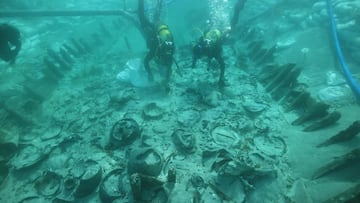Underwater find of “incalculable value” in Mallorca
A couple hundred feet from shore in a popular tourist area a diver found a sunken ship loaded with cargo that has been resting there since the 4th century.

Around the year 320 AD, a commercial ship loaded with hundreds of amphorae, ancient Greek jugs, filled with oil, wine and fish sauces was shipwrecked near the island of Mallorca. It remained buried in the sand for centuries until 2019 when a local found it diving at Ses Fontanelles beach, one of the most touristy beaches on the island. After several expeditions, researchers have recovered 300 complete amphorae with more than one hundred preserved inscriptions.
“The ship is a kind of compendium of the economic, social and religious evolution that at that time was about to occur in the entire Roman world,” said Enrique García Riaza, co-director of the recovery project. He assures that it is a “unique find” in the Mediterranean since it allows us to delve into the importance of the Balearic Islands during the time of the Roman Empire.
Among the objects that have been recovered, a ritual coin stands out, with which it has been possible to scientifically corroborate the hypotheses that were used regarding the shipwreck date of the vessel. According to elDiario.es, the currency could belong to Emperor Constantine (307-337 AD) or to Licinius I (307-324 AD).
A possible extraction
When the diver discovered the ship hidden under the waters, he immediately notified the authorities, who proceeded with an initial emergency archaeological intervention. The analysis work that began in 2019 is still ongoing thanks to its excellent state of conservation and all types of cargo stored in its hold.
Since then, the ship has remained for centuries about 213 feet from the coast and just over 8 feet below the surface. However, its extraction is scheduled for the coming months. Once it pulled out of the sea, it will then be moved to a temporary storage facility in the museum space at the Sant Carles castle. There, desalination work will be carried out for its subsequent conservation.
What has been recovered from the ship?
Among the objects that have been recovered by underwater archaeologists, a set of amphorae in perfect condition stands out, all of them sealed with stoppers that are engraved with a chrismon. The shipment also has garo, a gastronomic ingredient that is used to season sauces and was widely used in Ancient Rome.
Related stories
In addition, numerous bowls covered with a series of branches of grapevine have also been recovered. In Roman times, this was a common technique to cover dishes and thus cushion possible blows due to rough seas. Apart from the cargo, the crew’s own materials have also been recovered, such as two shoes, a lamp, hooks and ropes that are “very well preserved.”
Finally, the perfect condition of the wood used for the construction of the wreck reveals the origin of the materials used. The researchers conclude that pine was used for the longitudinal structure, while for smaller pieces harder woods such as juniper, olive tree or laurel were used. In short, the good general conservation of the ship makes it a “unique find” and of “incalculable value.”


Complete your personal details to comment